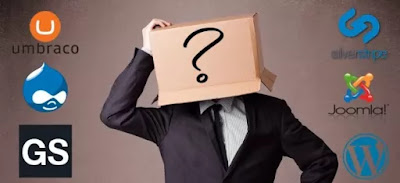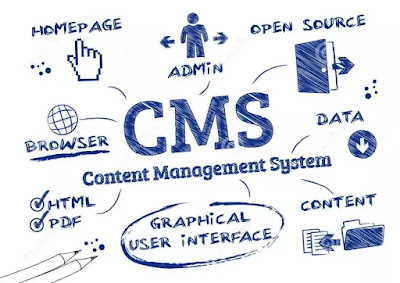Here comes the responsibility of web owners or who so ever is assigned a job to manage database properly what we call as Content Management System.
Basically, CMS is all about maintaining data of a company through a template which is generally a creation of a web graphic designer. If all set for what to present , then get ready for how to present it generates a need for choosing an effective CMS thereby resulting in good web traffic and increased business.
In today’s scenario where a human day starts with a cup of tea accompanying Internet access whether it is a social website for refreshing or most importantly in a need of a good content for a purpose. So it is the ultimate duty of a web developer, web designers, bloggers etc to present their content to user in an effective, organized and in a precise manner.
For this, systematic steps are needed to attain a fruitful business from its CMS.
First is preparing a catalog by identifying the needs of a business from it. CMS with the views of marketing department, users, web designers etc to cater the needs of CMS. Once we are ready with the abstract, the most considered criteria should be the needs and wants. Wants must be included but needs not to be is a major issue while preparing a list. Indeed some CMS are open sources but monetary aid is a major concern by hiring a company for the same if CMS needs to be updated for customer satisfaction.
Secondly, systematic investigation is required to have different CMS options.
List of various CMS needs to be maintained for choosing the best one. For this, reference needs to be taken from other business person by discussing the pros and cons. Once the search is being started, go through the CMS companies. Choosing a large or popular CMS should not always be the criteria.
WordPress, Joomla, Drupal, SilverStripe are some examples of CMS companies.
Many CMS companies are open source also, somehow if nobody in open source companies is providing information on how to use it, then supporting companies should be the best option.
If the company is not engaged with IT department, CMS expert is hired for technical support.
Now, ask CMS vendor to show the exact working of their CMS. Installation part needs to be understood first carefully and efficiently. Once finished with installation, ask for how often it needs to be updated because updating is an ongoing process that requires various steps in which consistency is a big and a major task to prevent halting a system. If you are an e commerce website, then maintenance at a large scale can prove curse.
Furthermore, front end and back end are primary concern. Front end is a look-and- feel of your website which is maintained by using a well-designed template.
Depending on the requirements to customize the appearance of a website, make sure that the current template is having the features for customization. With back end handling, ask vendor how changes at back end will be permissible because every business needs to change the information as required without any assistance.
 |
As some of the information is not published for public but only accessible to company employees, so functionality of intranet must be known. You should ask your CMS vendor towards progressive ideas of his CMS as business and customer grow and increase, so for customization our requirements would able to be fulfill or not.
Lastly, for choosing a CMS, use a sandbox version or demo from your selected 4-5 vendors. Choose the most effective employees for using demo in 1: n ratio of demo to people. Instruct them to upload information and see the changes.
Then select a CMS and prepare a deadline to be met. Before making commitment for a longer period, test it for some target period. After finalizing, implement it by conducting a needful training program for its proper use.
Examples of some CMS include:
1. WordPress
Currently, WordPress is the most liked and admired CMS for blogging. Majority of websites on Internet are using WordPress. Although, it started career as blogger platform but now it reached heights to Content Management System as its footprints are developing huge ecommerce portals, forums etc.2. Umbraco
It is in the top five most server applications. It is built on Microsoft .NET technology and many .NET developers use it as a CMS. Due to its no cost, quality of being understood, open source licensing, it is a choice of many developers. It is a matter of pride of having 85000 installation of Umbraco. Instead of using it as a personal blog, it proves a better CMS for organizations running large sites.3. Joomla
The biggest competitor of WordPress is Joomla. Joomla is having around above 7000 extensions that make it community very active. It’s very easy in Joomla to find extension of anything and loads of themes are available very easily. But to use it, one has to pay for its plugins and many more themes.4. Drupal
Drupal is also the most considered CMS by most of the web developers. Its new version Drupal 7 has been launched recently. Being easier to use, more scalable and its flexibility makes it a powerful open source content management system empowering millions of websites. Drupal forum is also very popular about its quick response of questions.5. SilverStripe
It is similar to WordPress but only limited to content management system rather than blogging. SilverStripe community is putting emphasis on translating their application framework and CMS into various languages. Perhaps, this proves many users to bend towards this providing a rapid growth in business. It maintains its reputation in having good hands on SEO also.6. GetSimple
It is the most simple content management system which is having everything a client needs. It is XML based CMS having a brilliant user interface. Regardless of having lot of features in large companies, it is very simple to use, easy to install and customize.So, now get set go and choose the most effectives CMS to design your website.






No comments:
Leave a comment
We love comments
You are important to us
Feel free to drop your questions or suggestions
Note: Your question must be pertaining to the post.